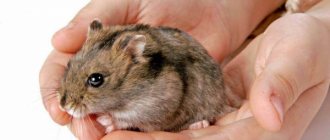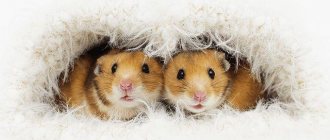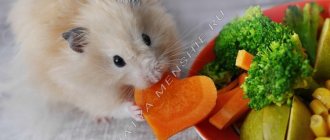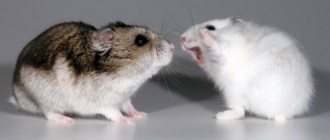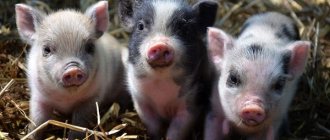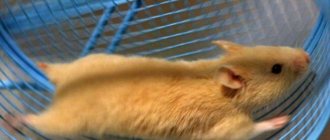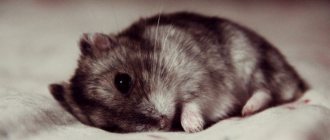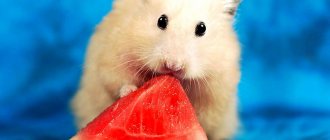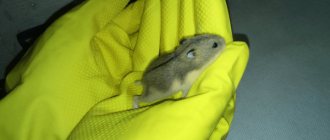- home
- Reproduction
15.04.2018
It is not uncommon for individuals of the same species to eat each other and their offspring. Cannibalism is inherent in insects, birds, primates, and predators. This phenomenon occurs quite often among rodents. The reason why hamsters eat their babies must be sought in the instincts of the animal.
First of all, it should be remembered that in their natural environment hamsters are loners. There is no need to introduce a friend or girlfriend to your pet so that the animal does not get bored alone. But if hamsters are brought together at an early age, they can exist quite peacefully in the same area, if the size of the cage allows. If the pets are of different sexes, be prepared for the imminent appearance of offspring.
Too early pregnancy and childbirth
A female hamster reaches childbearing age at 4 months of age. This is a physical opportunity to bear and feed offspring, but psychological maturation comes a little later. A mother who is too young may be frightened of her cubs and “eliminate” them simply because she does not know what to do with them next (you can compare this with pregnancy at 13-14 years old in a person; such a young girl rarely becomes a good mother). In subsequent pregnancies, such a female becomes an exemplary mother; past experience does not in any way affect the new cubs.
What happens in a normal nest
Being in position, the female hamster prepares a shelter for her offspring. After 3 weeks, up to 20 baby hamsters are born. To build a nest, you need soft material: napkins, paper towels, shredded paper, hay are suitable.
A thrifty housewife will create food supplies inside and outside the building. During pregnancy and feeding, the mother hamster's appetite increases, but the diet as a whole does not change. The main food products remain seeds, fruits, vegetables and pellets. Occasional treats are appropriate and fresh water should always be available.
How to make a toy for a rabbit?
Numerous offspring
On average, the number of children born at the same time in a hamster ranges from 7 to 20. If the female thinks that she is unable to feed all the offspring, she eats her hamsters to give the rest enough nutrition. She is told about difficulties by severe pain in her nipples. Babies, trying to suck out even a drop of milk, injure their papillae. This does not happen when there is enough milk in the breast for all the babies.
To improve lactation, a nursing mother is provided with a sufficient amount of clean drinking water and food. Moreover, the presence of only grain mixtures is not enough. During this period, the hamster requires an increased amount of protein food: boiled meat, eggs, cottage cheese, fresh vegetables, fruits and herbs. With good nutrition, the likelihood of eating offspring decreases.
An adult hamster ate another adult hamster
You should know that hamsters don’t just eat each other. This is abnormal rodent behavior. If this happens, you need to figure out what’s going on and prevent reoccurrences.
Causes:
- They divide the territory . Hamsters are territorial animals. In the wild, their entire territory is divided. Unless absolutely necessary, they try not to leave their possessions, and also do not allow strangers to visit them. If in nature there is enough space for them to separate and live separately, then at home there is no such opportunity. Owners make a mistake when two different-sex individuals inhabit the same cage. Hamsters are solitary by way of life. They don't get bored, they don't need a friend, and even without the owner's attention they feel good. Same-sex individuals should live in different cages, or they can be placed in one large cage, but be sure to install a partition. Even if one hamster does not eat the other, they can injure each other. Since hamsters are nocturnal animals, owners do not even suspect what happens at night. Due to daily fights, hamsters are constantly nervous and stressed, which significantly shortens the lifespan of rodents.
- Lack of food. Also, a hamster can eat another one if there is no food. If the owner forgot to leave food in the cage, then the feeling of hunger will force the hamsters to resort to cannibalism. The strongest will survive, the stronger individual will eat the weaker one.
- The female protects the offspring . Another situation in which a hamster can eat another is when the female is protecting her offspring. After mating, the male must be placed in another cage. Males lack nurturing instincts; they do not care or care for their offspring. If you leave a male in a cage and offspring appear, he will attempt to kill the cubs. For him, they are rivals with whom he does not want to share territory. To protect and save her cubs, the female can kill the male.
- Fight for the female . To breed hamsters you need 2 individuals of different sexes, where the third will be superfluous. If there is one female, and there is more than one male, then during the mating season there will be fights for the female’s attention. During this period, hamsters are quite aggressive and can bite an opponent to death.
Newborn defects
Since the number of hamsters born is quite large, they are often born with pathologies or injure each other after birth in the struggle for food. A hamster eats her children if she considers them incapable of life. This way she saves them from suffering in the future. Some cubs are already born dead. Usually the female eats them on the first day. If she has taken such a newborn to the corner of the cage, she needs to carefully remove it without disturbing the rest of the offspring. Long forceps or tweezers will help with this.
How to avoid loss of offspring
You can minimize the risk of hamsters eating their babies by following these rules:
- keep pets of different sexes in the same cage only during the mating period;
- prevent stress in hamsters;
- do not allow feeding of meat and meat products, including bone, blood and meat-and-bone meal;
- do not touch babies during breastfeeding;
- provide a complete diet for the female after childbirth;
- do not allow fertilization of females until 6 months of age;
- Separate babies from their mother at the age of 3–4 weeks.
Human intervention
A good breeder knows that hamsters do not allow strangers into their territory. Even simple cleaning of the cage, carried out without stress for the animal, is already a great art. A pregnant and lactating female is especially strict about protecting her area. A few days before the expected birth, you need to thoroughly clean the cage and transplant the expectant mother into a container. Add more bedding and add white paper napkins to equip the nest. If necessary, move the cage to a more convenient place. After the birth of the animals, you cannot touch it for at least a week.
After the birth of the babies, any physical contact between a person and a pet is prohibited for 1-2 weeks. The feed is added carefully, preferably using tongs. This is done in order to prevent the smell of a foreign animal from entering the cage (and a person is a foreign animal to a hamster). Seeing a threat, the female can rush to protect the offspring and bite the owner.
Do not allow children to approach the cage, look at the cubs, or pick up the mother or the hamsters. Sensing a foreign smell, the hamster eats her children, considering them strangers or sick.
When babies begin to eat food, the danger of being eaten becomes less. Even if the mother smells a foreign odor from the baby, she may refuse to feed him milk, but he is no longer in danger of starvation.
Preventing hamsters from eating their babies
Place the mother hamster in a quiet and peaceful place, away from children and other pets. Try not to make noise; you can cover the cage with a blanket.
Look at the babies, but do not touch them, especially in the first week of life. Provide qualitatively and quantitatively sufficient food.
Whether to get a hamster is up to you.
Star rating
[Total: Average: ]
Rivalry
Sometimes hamsters eat their teenage babies. This behavior is associated with the division of territory. The grown offspring become competitors and begin to be exterminated. Indeed, in nature, babies leave their mother at the age of 3-4 weeks.
Such a struggle may not be visible to a person. Hamsters that peacefully coexist during the day carry out massacres at night. Then they have an active time, in the morning the owner discovers the remains. Adult hamsters do not understand that they are eating their children; they simply eliminate competitors in the living space.
For the same reason, daddy hamsters eat children. Males completely lack the instinct to raise offspring. For him, newborns are strangers from the very beginning. Therefore, it is important to separate the male from the female immediately after mating. If this is not done, there are two options:
- the female will bite the hamster because she feels a threat to herself and her offspring;
- the male will eat the cubs, considering them a nuisance.
Both a wild hamster and domestic dwarfs will do the same, since their instincts are the same.
Possible reasons for eating baby hamsters
Offspring with health problems
In the wild, in order for the entire viable hamster species to survive, weak offspring are destroyed, which will interfere with the rodents' ability to escape from danger.
Domestic hamsters, which have long been tamed by people, remain true to their natural instincts, developed over centuries, which have saved them for a long time in the wild.
Born sick and weak, hamsters are usually eaten by their mothers. Injuries received by hamsters before or after birth equally make newborn babies weak and are immediately classified as non-viable. Such cubs, with almost one hundred percent probability, will be destroyed.
Important! If you notice a sick or even dead hamster in the cage, do not remove it; the female herself decides what to do with it. Your unnecessary interference may cause the death of all remaining offspring.
This is due to foreign odors. Not being able to smell herself, the mother may start to panic and kill the rest of the newborn hamsters. Don't worry, these rodents eat everything, including meat. No matter how shocking it may sound, the female herself will “clean up” her nest.
If this does not happen within several days, then use gloves to remove the dead cub. This will at least somehow protect other hamsters from your smell.
Unpreparedness to become a mother
Often, the first pregnancy of a female hamster can cause severe anxiety, anxiety and drive the young mother into a stressful situation.
Unpreparedness for maternal responsibilities can be another reason for cannibalism in hamsters.
The female is not ready for pregnancy, nor for giving birth and caring for her babies. This reason can provoke the killing of unwanted offspring. The subsequent gestation of offspring and their birth usually do not cause such a reaction in the female.
Weight of cubs
Many or seemingly large numbers of newborn babies. Having become a mother for the first time, doubts overcome both people and animals. Can I cope, do I have enough milk? Your female, who was very small herself, gave birth. I lost a lot of energy and vitality. And then numerous newborn offspring squeal nearby and ask for food. The hamster may panic and think that she won’t be able to feed everyone, and it will be difficult to cope with such a horde of babies. Therefore, this is where natural instinct kicks in; several individuals of the offspring can be eaten.
In order not to provoke the occurrence of such a situation, the owner needs to improve living conditions and improve the hamster’s nutrition as much as possible. She now needs nutrients and minerals, as well as vitamins. Feed her special food for pregnant females, vegetables and fruits. Don't forget about clean water.
Male living with offspring
After the process of mating a female with a male, they must immediately be separated into different cells. This is due to the fact that the male is completely devoid of any parental instincts. He will not even think about whether to leave his offspring or not, he will destroy them.
Some owners think that the hamster is jealous of the offspring of the female and receives little attention from her. In fact, such passions do not need to be attributed to them. Let us remember that the hamster is a loner by nature. And the struggle for territory is ongoing all the time. Here in the cage there is a whole brood of competitors, which are easier to deal with while they have not yet grown.
What do newborn hamsters look like?
Why do dogs eat grass? Newborn hamsters are completely hairless, so they look like a red, swarming mass. Their ears and eyes are closed; only their sense of smell allows them to navigate. Babies may squeak loudly if they are cold or hungry. If the mother takes good care of the offspring, the babies do not make a sound. Sometimes the owner discovers that there are newborn hamsters in the house, by accident - when cleaning the cage, or when grown-up children of hamsters begin to crawl out of the nest.
Newborn hamsters
A baby hamster is no larger than the phalanx of a finger, weighing 1-2.5 g. In the first days, it can be difficult to count the offspring, especially since the female feeds the children, lying on them with her whole body. It is not recommended to look into the house so as not to disturb the hamster.
Although dwarf hamsters are much smaller in size, newborn Syrian hamsters are not very different in size from dwarf hamsters. The fact is that Syrians are multiple: the more children in one litter, the smaller the size of each hamster.
Newborn Hamster Size
Hamster cannibalism: why do hamsters eat their babies and each other?
Hamsters are funny, furry creatures that delight almost everyone. The news that your female is expecting a new baby evokes a variety of feelings. It could be delight, or it could be fear of problematic situations arising.
The only thing that shocks all hamster lovers is that your cute furry little ball can eat its own babies. What is the reason for this behavior? Let's figure it out. Let's find out why this happens and how to prevent cases of cannibalism in your hamsters.
Unpreparedness for motherhood
Also, one of the possible reasons why hamsters eat their children is the hamster’s unpreparedness for motherhood. This is especially common during the first birth. The young hamster does not yet feel ready for childbirth and motherhood. This causes her a lot of stress and can have the unfortunate result that she will eat her young. Interestingly, this usually does not happen during subsequent pregnancies and childbirths.
If the female refuses the cubs, you can try to feed them yourself. But you need to look at things realistically and understand that this is a very labor-intensive process that takes a lot of time. Hamsters are fed using a syringe, of course without a needle, or with a pipette. The most important thing is to feed the cubs every 2-4 hours! Are you ready to say goodbye to your usual way of life for three weeks and devote all your time to your kids? You decide.
We save baby hamsters ourselves
As a last resort, if the hamster abandoned the babies she gave birth to, you can try to get them out yourself. This is a rather complex and difficult process that requires increased care and patience from you. You need to feed hamsters from a pipette or from a dispenser; you can use a syringe without a needle. Feeding should be regular, constantly every two to four hours for three weeks. Will you be able to change your rhythm of life and adapt to a newborn hamster family?
Why do hamsters eat their offspring?
Amazing picture. Life goes on as usual, there is plenty of food and water, a cozy nest has been built. And suddenly such cannibalism, in the midst of complete prosperity. Why?
Stress
Postpartum stress, if you will. Ask any mother what it’s like to bear, give birth, and feed your baby. The usual way of life changes seriously, and long-term depression sets in. Hamster mother is no exception. In some cases, she comes to the “realization” that she has given birth to more babies than she physically can “handle.” By the way, this is quite possible when you constantly disturb a young mother during the day. Be tactful and patient.
Fear
Another natural feeling, especially in such small animals as hamsters. Fear has big eyes, especially during such an interesting period. The female shudders at every rustle. And if the owner’s cat frequents the cage... The unexpected happens. Wanting to protect the babies, the mother eats them. Horrible but true.
Smell
Mom spends a lot of time caring for and caring for her babies. Mom knows the smell of her babies very well; she recognizes it from a thousand. But sometimes everything is spoiled by overly curious owners who love to peek and even pick up the cubs. They immediately begin to smell new, different. Mom is confused and now cannot identify them. And he no longer considers them his own. We invite you, dear readers, to continue the logic of our reasoning.
The cubs are destroyed by the male
This problem often arises when domestic rodents eat each other or their offspring. Many believe that the main reason for such terrible behavior of hamsters is their cage together. But is this really so?
The male, who is in the same cage with the hamster, feels rejected after the birth of the offspring. Small rodents are real competition for him. That's why he eats them. After the birth of the cubs, the mother becomes especially aggressive and does not allow the male to approach her. The lack of opportunity to mate prompts the male to take such actions.
Another important point is that if hamsters of different sexes are constantly in the same cage, then the hamster will bear offspring every two weeks. She becomes weak, like each subsequent offspring that is born. Weak hamsters are simply doomed to death. Sooner or later they will be eaten, if not by the female hamster, then by the male.
Coprophagia: norm or pathology
Coprophagy in a healthy and beneficial manifestation is observed in animals. For people it is unnatural and an indicator of mental deviation. But in the animal world, coprophagy is part of the animal's food cycle. When consuming different foods, the stomach of guinea pigs does not always absorb all the nutrients. And so partially processed food is eaten for processing a second time. For the health of domestic rodents, this form is an integral and beneficial part of the food chain. Eating feces normalizes intestinal function, receives missing vitamins, and processes lumps in the stomach.
Common causes of falling on your back
However, not everything is so scary. When a hamster falls on its back, it may just be playing. The main reasons that can cause an animal to fall are:
And yet, if the hamster falls on its back, tumbles, runs on the drum, behaves actively, eats well, there is no need to worry, since everything is fine with it. In order to understand what provoked such animal behavior - a desire to have fun or illness, it is enough to observe for some time.
Due to excitement, it is difficult to figure out what to do if the hamster lies and does not move, but is breathing. After all, the presence of breathing means that the animal is still alive.
Before you run to the vet, you need to try to figure out why your pet is lying motionless
Pay attention to other signs: whether the eyes are closed, how often the rodent breathes. If the eyelids are closed and breathing is calm, the hamster may just
If a previously healthy animal suddenly falls into a coma, it is possible that it is hibernating. Breathing will be very rare, and the pet will be cold to the touch. In nature, dwarfs hibernate in winter, waiting out cold, hunger and short daylight hours.
Low room temperature
If the heating was turned off in the apartment, or you were going on vacation, this could provoke numbness. The body will be cold, the heartbeat will be extremely rare (1 beat every 15 seconds). A sleeping hamster can barely breathe; due to its small size, it is difficult to understand whether there is breathing at all. But if the body remains soft, the rodent has not died. To awaken the animal, the cage is placed in a warm room (more than 20 C), the feeder and drinking bowl are filled. The hamster should wake up in 2-3 days.
Heat
The Djungarian hamster lives in the steppes, and the Syrian even in semi-deserts, but both species are extremely sensitive to high temperatures and direct sunlight. Tiny nocturnal rodents with dense fur have no protection from overheating - they do not sweat or breathe through their mouths like dogs. Heat stroke is deadly for them.
Signs of hyperthermia:
- the hamster does not move and is breathing heavily;
- weakness;
- convulsions;
- impaired coordination of movements.
In case of acute overheating, heart failure leads to the death of the pet. Death may not occur immediately, but within a couple of days due to the failure of all organs, if the temperature has risen so much that proteins have coagulated in the blood and organs (at 44 C).
Situations in which there is a risk of heat stroke
- a cage on a windowsill or balcony, outside (sun);
- near heating devices;
- in a stuffy room with high humidity.
It can be difficult to understand why a hamster is lying on its side and breathing heavily if by the time the owner returns the sun has already gone and does not illuminate the cage.
Treatment for heat or sunstroke
Transporting a pet to a clinic in case of heat or sunstroke is not the best solution; time for first aid will be missed. What can you do without the help of a veterinarian to help your pet:
Reduce temperature
First aid is to cool the body, but not too sharply: applying ice or immersing the hamster in water is prohibited! The animal is placed on a tile or ceramic dish, or on a damp towel
Gently moisten ears and paws with cool water.
Fighting dehydration
Heatstroke very often occurs when there is no access to. When the animal is unconscious, it can no longer use the drinking bowl. However, it is also dangerous to drink a hamster from a syringe: it will not swallow, and the liquid will enter the lungs, making breathing difficult and causing pneumonia.
The liquid (sterile Ringer's solution or sodium chloride) is injected subcutaneously into 4-8 ml of Syrian and 2 ml of Djungarian hamsters.
Antishock therapy
Although all potent medications are best used as prescribed by a doctor, in a situation with acute overheating, the hamster may not survive to take the ratologist. If you feel like you have nothing to lose, you should inject prednisolone 30 mg/ml intramuscularly (in the hind leg) with an insulin syringe. The dose for a Dzhungarik is 0.05 ml, for a Syrian - 0.1 ml.
Whether your pet survives may depend on how long it was exposed to the high temperature. If the hamster does not die immediately, on the first day after overheating the owner often notices that the hamster falls over on its side and can barely walk. Neurological disorders are associated with swelling of the brain, and if the pet survives, coordination of movements will gradually be restored.
Reason 1. Your intervention
During pregnancy, a female Djungarian hamster becomes very irritable, let alone the first hours after giving birth. That is why your hand trying to change the water or move the bedding will cause another wave of stress, which will have a disastrous effect on the homea, after which it is quite capable of eating its offspring.
In order to avoid such a turn of events, all procedures with the cage should be carried out in advance, this applies to replacing water, food and bedding, preparing a future nest for the mother and cubs.
Cleaning should be carried out 4-5 days before the expected birth, so that the female has time to prepare everything and make supplies, the destruction of which will cause great stress.
A week before giving birth, provide the expectant mother with white napkins or paper towels without a pattern, with the help of which the female will build a nest for her cubs. And then, the best way out will be your non-interference, and you can start cleaning the cage a couple of weeks after giving birth.
Why does a hamster eat her babies?
Nature has endowed the maternal instinct not only with people, but also with animals. But it also happens that for some reason the female does not want to take care of the offspring. Among the reasons why a female hamster can dine on her babies are:
- Mothers who are too young, as a rule, do not yet have a strong maternal instinct; this applies to hamsters under four months of age.
- The main reason is the lack of milk in the female; the mother is forced to kill half of the offspring in order to feed the rest. Make sure that the new mother has 24-hour access to water and wet food, her diet greatly affects milk production.
- The so-called natural selection also plays a role; mother hamsters can eat a baby hamster that is too weak.
- Females after giving birth are very aggressive, they can eat the cubs under the slightest stress, be it bright light or strong noise.
- You should not pick up newborn hamsters or disturb their house; the mother may not recognize the children by smell if you touch them.
- Most often, children are eaten by females weakened from frequent childbirth, as well as those who gave birth through family ties.
Hamster is not ready
This is a very likely reason that a hamster eats its babies during the first birth. He simply does not feel ready, the maternal instinct is not developed. Subsequent pregnancies will not bring such problems. In this case, you can try feeding the children yourself. But be prepared that this will take a huge amount of your time. You need to feed them milk through an injection without a needle or a pipette every 2-4 hours. That is, you will get rid of normal sleep for 3 weeks until they can feed on their own.
A breed of Syrian hamsters emerged from a laboratory in Jerusalem.
The first hamsters were domesticated in the 1930s thanks to the efforts of a Jewish biologist. In 1930, he went to Syria in search of these rodents. The motivation for the trip was that his team considered hamsters to be close to humans in physiological parameters. Thus, they could be used for drug testing. However, after he took several individuals for himself, they began to multiply at tremendous speed, and the scientist had to start distributing them. Thus, all Syrian breed hamsters are related to individuals that were obtained by scientists in Syria and brought to the laboratory for experiments.
Found a violation? Report content
Large or seemingly large numbers of young
The first birth is always difficult and not only for people. Having experienced such stress, a hamster may lose confidence in its abilities. Well, imagine - such a baby suffered a pregnancy, which took a lot of strength and nutrients, followed by a painful birth, and numerous offspring that need to be fed somehow! The hamster may panic and decide that she cannot cope with so many offspring and will eat several individuals. To avoid such a sad situation, it is necessary that the animal’s nutrition is as complete as possible; there is no deficiency in vitamins and nutrients. This should include special food, fresh fruits and vegetables, and clean water.
What to feed small hamsters at home
Females with good lactation can feed their offspring for up to 1–1.5 months. But most often, a hamster’s milk disappears by the end of the second week after birth. Further in the article you can read about what diet babies prefer depending on their age, and whether it is possible to feed newborn hamsters on your own.
Newborns
Like all representatives of the animal kingdom, the best food for newborn offspring is their mother's milk. But there are times when the female is not able to feed her babies. This can happen for various reasons - undeveloped maternal instinct, lack of lactation, or the death of the female during childbirth. If the babies have lost their wet nurse, then you can try to feed them with regular baby formula. In the first week, hamsters need to be fed every three hours during the day and twice at night. For convenience, you can use an insulin syringe without a needle.
Important! If you have found a new nurse for your offspring, do not rush to immediately place the babies with her. First of all, wipe them with bedding from the female’s nest, lure her out and carefully place the hamsters with others. To prevent your scent from scaring off the female, use a teaspoon to transfer the hamsters.
1–3 weeks
Starting from a week old rodents, you can put finely grated vegetables and fruits, as well as boiled cereals and crushed food in their nest. This way, you will begin to introduce them to adult food, and if the female’s milk runs out, her offspring will not remain hungry. If small hamsters are bottle-fed, then the amount of mixture prepared for each feeding is gradually reduced.
Menstruation
At the age of 4 weeks, rodents can already find and eat solid food on their own; there are now no restrictions in their diet. They do not need mother's milk or formula.
The mother is not able to feed so many children
Most often this happens during the first birth, when the hamster is not confident in itself. Not only did pregnancy take a lot of energy and nutrients, then childbirth took the last of my strength, and then there are so many mouths to feed. The hamster may conclude that she cannot cope with everyone, this will cause the hamster to eat some of her babies. He will leave as many as he can feed.
Proper nutrition, which contains all the necessary nutrients, will help avoid this outcome. That is, there must be both special food and vegetables, fruits, vitamins and water.
The female eats the young
Any mother protects and takes care of her offspring. This feature is inherent in the genes of all females. But this theory is refuted by the fact of cannibalism, which is possible in female hamsters. Why do hamsters eat their babies?
It is not uncommon for a hamster, being in a cage with her babies, to simply eat them. Some believe the main problem is the lack of liquid food in the cage, others believe it is the lack of water.
Owners should monitor the maintenance of hamsters
According to experts in the field of animal husbandry, it is the lack of fluid that is the main cause of cannibalism in hamsters. This can be explained by the fact that during the lactation period, the hamster, like any other female mammal of the species, has an increased need to drink. The liquid helps the mother's body produce milk. When lactation decreases, hamsters sucking the hamster's papillae cause her unbearable pain. It is a signal to the female that the offspring will not survive due to lack of milk. As a result of this, the animal instinct is triggered, and the mother eats partially or completely the cubs.
You can avoid such consequences. A few days before the babies are born and during the feeding period, the hamster should be given wet food and protein foods (cottage cheese, milk, boiled chicken meat). There should always be clean and fresh water in the drinking bowl. In such conditions, the hamster will be loyal to her babies.
The female or male eats the offspring
Hamsters are not only easy to keep at home, but they also breed easily in captivity. To avoid cases where a female or male eats their offspring, it is important to study breeding information, prepare and change the diet, housing conditions and care.
If not properly cared for, the female will be forced to eat her children in order to save them from unfavorable conditions. Yes, that's exactly how she eats them, to protect them. Let's figure out in what cases this happens.
Reasons why the female eats the offspring:
- First pregnancy . Puberty in hamsters occurs at the age of 2 months. But it is better to allow individuals who are 4 months old to be bred. Early pregnancy can have a negative impact on the offspring. The female is simply not ready to become a mother. She does not understand what is happening and is in a stressful state. Because of this, the female can eat all the offspring. This can happen during the first pregnancy, even if the female has reached the age of 4 months or more. However, subsequent pregnancies usually go well and previous experience does not affect the offspring in any way.
- Alien smell . During pregnancy, the female should approach the cage only as a last resort, to fill the feeder or drinking bowl. During this period, it is not recommended to even clean the cage. When the cubs appear, you should never touch them with your hands. A foreign smell can repel the female from her offspring; she will consider them alien and destroy them. Small hamsters can be handled no earlier than 2 weeks after birth.
- Lack of food and supplies . In normal times, hamsters' supplies are often taken away because the food spoils and becomes hazardous to the hamsters' health. It is not recommended to clean the pantry during pregnancy and after childbirth. If some products have spoiled, they should be removed and replaced with others. In the absence of food, the female, saving her offspring from starvation, can also destroy them.
- Extraneous noise . Small hamsters are very shy. The cage should not be placed near a music center or near a TV. If the female is frightened, she may eat her offspring to protect them from danger.
- Other animals . Rodents are rarely friends with other pets. They often feel threatened and are stressed. And when the female is frightened, she destroys the cubs.
- Sick cubs . It happens that some cubs are born sick or already dead. There is no point in removing a dead hamster; let the female decide what to do with it. If she doesn’t touch him for a couple of days, then you need to put on a glove and carefully remove him from the cage. If the female decides that some of the babies are sick, she will destroy them so that stronger and healthier individuals survive.
- Large offspring . If many babies are born, the female needs to increase her daily food intake and also add vitamins to her diet. If the female feels that she is not able to go out and feed such a number of cubs, then natural instinct will kick in and some of them will be eaten.
- Male in a cage . After mating, the male must be placed in another cage. Otherwise, the female will be forced to protect the offspring. And if the male is stronger, she will eat the cubs to protect them.
- The male can also if he is not placed in another cage. He has no paternal feelings; for him, cubs are rivals with whom he needs to share territory. The female may not be able to cope with the male, and he will eat all the offspring.
To avoid cases of cannibalism, you should adhere to the rules for keeping hamsters. Same-sex individuals cannot be housed in the same cage; after mating, the male must be separated from the female. It is also necessary to create favorable conditions for pregnant hamsters and select a special diet, which, in addition to the grain mixture, should include vegetables and fruits, as well as vitamins and mineral mixtures.
Other causes of cannibalism
Sometimes it happens that young mother hamsters eat the first litter. This does not happen because they are considered bad mothers. It’s just that the young individual does not fully understand what happened to her, and eats the hamchat as a nuisance. With the next offspring she will be loyal.
Some believe that the female eats babies that do not match her color. For example, if the mother is black, and the hamsters were born black and white or white, then she will certainly eat them. It's all a myth! The color of the cubs has nothing to do with it. A Khomchikha can regulate the number of her offspring, taking into account her maternal capabilities.
Features of reproduction
Among the people, hamsters are known as very prolific animals, although this is only partly true. In captivity, hamsters actually breed all year round, but in the wild they obey instincts and reproduce only in the spring and summer. On average, a female gives birth 2–4 times per year, and the number of cubs in a litter varies greatly - from 1 to 18, but on average 8 animals are born in a litter.
The ability to reproduce offspring occurs already at the age of 1.5–2 months, although at such an early period pregnancy may not end successfully. It is optimal to mate a female from 4 months and a male from 3 months. In this case, the male can be used as a sire until the age of 10 months.
Did you know? Did you know? The most numerous offspring of a hamster is a litter of 26 cubs, which was produced by a hamster from the American Miller family in 1974.
Excessive attention from owners
Close attention and excessive care will harm not only human relationships, but can also cause cannibalism in female hamsters. Since this rodent is a solitary animal, and after the birth of the cubs, the female needs a secluded environment and tranquility even more, excessive care will only harm these animals. Do not pick up hamsters and do not get into the cage. Let your family see you less.
Related Posts
Foreign odors repel the mother hamster. Sensing a foreign smell, she does not identify the cubs as her own creatures and, as a result, abandons them and destroys them. Do not touch the hamster family for one to two weeks after the babies are born!
It is necessary to prepare in advance for the new offspring of furry rodents. When cleaning the cage, if you find hamster supplies, do not touch them. This is a strategic supply of products, which unpleasantly traumatizes the animal’s psyche in the event of its loss, even to the point of an uneven breakdown in a pregnant female. Only spoiled products can be thrown away to avoid the growth of putrefactive bacteria, odor and poisoning.
To arrange your own nest, it is recommended to put a few paper napkins. Your task is to fill the drinking bowl with clean drinking water and pour food into the feeder on time. This is all that the rodent needs from its owner at this time. Nature will do the rest.
